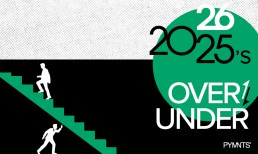JPMorgan’s latest results, released Friday (July 12), showed that consumers continued to use their cards in full force, for both debit and credit payments.
And though there are pockets of weakness in spending from lower income cohorts, according to management, spending trends are still strong — and there remain opportunities to grow presence in the card market.
The second-quarter results and supplementals from the company indicated that credit card loans were up 13% year on year to $216 billion, up 5% from the first quarter.
Debit and credit card sales volumes were up 7%, to $453 billion in the most recent period.
Drilling down a bit, credit spending, in terms of sales volumes, were 8% higher vs. last year, to $316.6 billion, which represented a 9% surge from the first quarter.
There was a 7% gain in active mobile customers to 55.6 million. Active digital customers, overall, were 5% higher through the same timeframe, to 69 million.
Advertisement: Scroll to Continue
During the conference call with analysts, JPMorgan CFO Jeremy Barnum said there’s been little impact from spending shifts in an inflationary environment. (CEO Jamie Dimon was absent from the call due to an overseas “travel conflict” mentioned on the call.)
Charge-Offs and Credit Metrics See ‘Normalization’
The net charge-off rate on card loans, per company data, stood at 3.5% in the second quarter, up from 3.3% in the first quarter and 2.4% from a year ago. Average deposits, overall, were down 1% quarter over quarter and down 7% year on year to just over $1 trillion as holders, said Barnum, rotated into higher yielding accounts.
Barnum said that credit performance was “predominantly driven by card as newer vintages season and credit normalization continues.”
With a nod to the commercial lending environment, Barnum observed that “demand for new loans remains muted as middle market and large corporate clients remain somewhat cautious due to the economic environment.”
Amid questions about loan demand, Barnum noted that “our card business is, of course, no way capital constrained. So, whatever growth makes sense there in terms of our customer franchise or ability to acquire accounts and retain accounts, and what fits inside our credit risk appetite, is growth that’s going to make sense.”
Asked on the call about credit performance, Barnum said that “when it comes to card charge offs and delinquencies, there’s not much to see there — it’s normalization, not deterioration. It’s in line with expectations.”
As has been consistent with commentary in bank earnings from earlier this year — noting pressures for specific customer cohorts — Barnum said that there’s “behavior that consistent with a little bit of weakness in the lower income” client base.
There has been a rotation from discretionary spending to discretionary categories, though the impact has been “subtle … it all kind of hangs together, in what is, sometimes, actually not a very interesting story.”
PYMNTS Intelligence data has noted that, among the lower income demographics — those making less than $50,000 annually — and in reference to that non-discretionary spending, paying for food (25%), housing (37%) and their monthly bills (13%) now accounts for 72% of their monthly income.
Shares of JPMorgan were 2% lower at the start of trading Friday.




